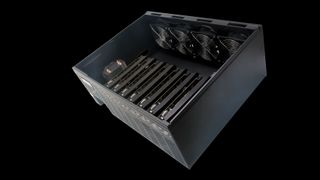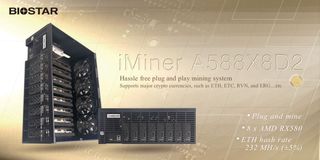Biostar Fits Eight RX 580 GPUs Into 232 MH/s Mining Monster
Are you looking for your gold mine?

Biostar has launched a new mining rig that wields the combined grunt of eight AMD Radeon RX 580 GPUs. The system, dubbed the Biostar iMiner A588x8D2, uses what appear to be eight consumer-grade Radeon graphics cards with DVI/Triple display port/HDMI outputs and a twin fan cooling design. The cards look like the Biostar Gaming VA5805RV82 model with 8GB of VRAM. In its press release, Biostar says that it can deliver iMiner systems in "large quantities."
Biostar has a history of crypto mining hardware development, dating back quite a while. For example, it has launched many BTC-series motherboards across processor generations, featuring as many as twelve PCIe slots. The new Biostar iMiner A588x8D2 featuring eight RX 580 graphics cards has used its motherboard technology as a platform. Biostar has previously based lower power iMiner systems on multiple RX 570 8GB (8x) and RX 560 4GB GPUs (12x).
As a crypto mining system isn't GPUs alone, Biostar has kitted out this system with an Intel G4900 processor (2C/2T) and 8GB DDR4 RAM. It says the system can run Windows, Linux, or HiveOS, and we note previous members of the iMiner series ran the ethos 64-bit Linux mining distro. The case looks quite roomy and features four 120mm fans and a specially made "blockchain grade" PSU.

Biostar says that the new iMiner A588x8D2 can deliver an Ethereum hash rate of up to 232 MH/s ± 5% for crypto mining performance. But, of course, this system isn't only for ETH mining (which might not be suitable for if/when ETH changes from proof of work to proof of stake); it can also tackle ETC, RVN, ERG, and other altcoin mining jobs.
If you are in the market for a graphics card for 1080p or some 1440p PC gaming, you could do worse than getting a used or new Radeon RX 580, depending on the price. New GPUs with RX 580 level performance are still being available or in planning, such as the state of the GPU market in early 2022.
Biostar's press release boasts, concerning iMiner A588x8D2 systems, that it "guarantees availability in large quantities for any interested party." Thus Biostar must be sitting on large quantities of Radeon RX 580 cards or components to make them.
Stay on the Cutting Edge
Join the experts who read Tom's Hardware for the inside track on enthusiast PC tech news — and have for over 25 years. We'll send breaking news and in-depth reviews of CPUs, GPUs, AI, maker hardware and more straight to your inbox.

Mark Tyson is a Freelance News Writer at Tom's Hardware US. He enjoys covering the full breadth of PC tech; from business and semiconductor design to products approaching the edge of reason.
-
cryoburner Remember a few years back after the crypto market crashed the last time, and RX 580s were discounted well below MSRP and bundled with popular new game releases as companies tried to get rid of their glut of inventory? Biostar must have found a bunch of leftovers in a warehouse and are trying to get rid of them before that happens again.Reply
It doesn't really seem like a particularly good time to be investing in mining equipment built around nearly 6 year old graphics technology. -
InvalidError Reply
Why send those cards for retail at $300 a pop when it can probably get $500 per GPU for itself and probably unload some other unwanted inventory like DDR4-2133 DIMMs, excess mining motherboards and more along the way by selling direct to miners as a pre-built 8-GPUs unit?peachpuff said:Biostar says that it can deliver iMiner systems in "large quantities."
Dicks...
Sucks for consumers but great opportunity for SIs sitting on heaps of obsolete parts. -
watzupken Biostar has never been shy to sell mining hardware openly. They done it before, and they are obviously doing it again. While people may be upset with them, the truth is that the other AIB partners are probably doing the same. They just do it on the sly. Otherwise, why do you think the likes of AMD/ Nvidia and their AIB partners making record profits quarter after quarter when they have "supply issues/ low supply". The low supply is because the bulk of the supply is being sold to miners at a fat margin, with likely little to no after sales support (warranty), since these are destined for 24/7 work and will void warranty. Also, the increase in profit is not like 10% more each quarter, but record breaking profits.Reply -
david germain isnt Eth leaving 'proof of work' soon.Reply
Also what is a kW usage? 3.5Kw will get you 130Th/s+ Intel's new miner. -
InvalidError Reply
While ETH may go PoS, you still need PoW to generate new blocks to stake so there will still be people mining to stake instead of mining for direct profit.david germain said:isnt Eth leaving 'proof of work' soon.
Also what is a kW usage? 3.5Kw will get you 130Th/s+ Intel's new miner.
Also, Intel's mining chips are for Bitcoin, not ETH. Bitcoin has a low-footprint hash function which can be fully integrated within an ASIC by the hundreds per chip while ETH's DAG requires 5-6GB of memory, high bandwidth and low latency for each instance, hence its "memory-hard" (performance dictated by memory IO) classification. -
artk2219 The RX 480 and 580 definitely missed their time to shine in the gaming scene, they were always more popular as mining cards. It's also kind of insane that 6 years after Polaris's launch, its still being produced new, and if you can actually find one for gaming, it still puts up a fight in the intro 1080P gaming market. That being said, it sucks that eight of these are going into one mining rig instead of 8 gaming PC's 😕 .Reply -
david germain Reply
Cheers for clearing that up.InvalidError said:While ETH may go PoS, you still need PoW to generate new blocks to stake so there will still be people mining to stake instead of mining for direct profit.
Also, Intel's mining chips are for Bitcoin, not ETH. Bitcoin has a low-footprint hash function which can be fully integrated within an ASIC by the hundreds per chip while ETH's DAG requires 5-6GB of memory, high bandwidth and low latency for each instance, hence its "memory-hard" (performance dictated by memory IO) classification. -
david germain Reply
Just did a look with factoring in your new info. And Bitmain Antminer E9 will do eth mining @about 3Gh/sInvalidError said:While ETH may go PoS, you still need PoW to generate new blocks to stake so there will still be people mining to stake instead of mining for direct profit.
Also, Intel's mining chips are for Bitcoin, not ETH. Bitcoin has a low-footprint hash function which can be fully integrated within an ASIC by the hundreds per chip while ETH's DAG requires 5-6GB of memory, high bandwidth and low latency for each instance, hence its "memory-hard" (performance dictated by memory IO) classification. -
LolaGT The proof of stake thing is kind of a misnomer.Reply
GPU based crypto mining isn't going anywhere for years yet, regardless of ethereum.
What the market will do as far as boom or bust is another thing entirely.
Most Popular

